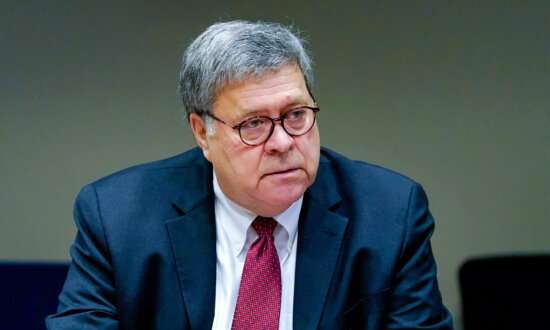The New York Times breathlessly reported last week where the investigation of the present Special Counsel’s Office has ended up: At the Washington D.C. think-tank The Brookings Institute. It’s kind of funny that only now are readers of the New York Times learning what Uncover DC reported on a half year ago.
It’s supposed to be breaking news that Special Counsel John Durham’s investigation into how SpyGate began is placing a major focus on the infamous Steele Dossier and how it was used by both the media and corrupt officials inside federal agencies to drive the fake Trump/Russia Collusion Hoax during and following the 2016 election?
TELL ME MORE NEW YORK TIMES!
And I’d give you three guesses as to why Durham’s office is focusing on the Brookings Institute and a former Russian researcher who used to work there named Igor Danchenko, but if you’ve been reading my columns, you’d only need ONE.
Long-time SpyGate researcher on Twitter, DawsonSField, posted this on reading the Times’ story:
Defensive leaks to the NY Times, the way the Swamp gets their narrative out ahead of the news.
Looks like Brookings stalled producing evidence on Danchenko until after the Trump Admin were gone. What did they not want them to see? https://t.co/aSPsI3mbPe pic.twitter.com/3krcM2JWeb
— DawsonSField (@DawsonSField) April 13, 2021
Not only did Brookings’s delay handing over the subpoenaed documents until Trump was safely out of the White House, they appear to be so nervous about what Durham’s investigators are going to find in those documents that they are running to the NYT’s to get ahead of what’s coming and make sure their own spin is out there first.
According to the New York Times mysterious anonymous leakers:
“But one aspect [of Durham’s probe] has come into focus recently, according to people familiar with the investigation: Mr. Durham has keyed in on the F.B.I.’s handling of a notorious dossier of political opposition research both before and after the bureau started using it to obtain court permission to wiretap a former Trump campaign adviser in 2016 and 2017.”
You know who’s familiar with the investigation Durham is doing? TARGETS of the investigation. People who are brought in for interviews and are the subjects of subpoenas. They become aware of what the investigation’s focus is.
Why Are Targets of Durham’s Investigation Leaking to The New York Times As Anonymous Sources?
This is a defensive leak by people at the Brookings Institute to get out ahead of Danchenko not being Steele’s source for his fake dossier.
Of course, the New York Times or CNN won’t come right out and tell you this.
“Our sources for this story are the people who are the targets of the Durham investigation, who have been interviewed and have received subpoenas.”
Oh no. It sounds so much better to say it this way:
“Our sources for this story are people familiar with the investigation and we want you to imagine they work at the DOJ or inside the Special Counsel’s office.”
As I discussed in a recent column at the Epoch Times, they never tell you who their anonymous sources are for their fake news stories because they want the reader’s imagination to run wild and because if readers knew who the actual source was, they’d realize they were being tricked. The anonymous source is never who they want their gullible readers to imagine that it is.

So, targets of the Durham investigation are now being used as anonymous sources for CNN and New York Times defensive/damage control leaks to…get out ahead of something about the Brookings Institute and Igor Danchenko. And possibly whoever the real sources of Steele’s fake dossier were.
Danchenko’s Disavowal of Being Steele’s Source Opens A Door
In my column from July of last year about Danchenko, I made several key points:
- The proper FISA surveillance warrant process was not followed for the Carter Page wiretap. The FBI only went to interview Danchenko 3 months after the information that supposedly came from him had already been used for the warrant. They waited until the warrant was up for its first renewal to try to verify Christopher Steele’s claims about what his ‘highly placed Russian main source’ supposedly told him.
- During the January 2017 interview, Danchenko strongly disavowed to the FBI agents that he was the source of the allegations against Carter Page or any of the other accusations against Trump associates found in Steele’s dossier.
- Even after hearing Danchenko deny being the source of the allegations, the FBI agents running Crossfire Hurricane went ahead and renewed the surveillance warrant. And they went on to renew it two other times.
Now, think of all the right questions a real journalist would ask once they knew all of this and notice the New York Times asks none of them.
New York Times Won’t Ask the Right Questions
Look how the New York Times’ reporters carefully word this part of their report:
“In addition to questioning witnesses who may have insight into the matter, Mr. Durham has obtained documents from the Brookings Institution related to Igor Danchenko, a Russia researcher who worked there a decade ago. Mr. Danchenko later helped gather rumors about Mr. Trump and Russia for that research, known as the Steele dossier, according to people familiar with the request. By asking about the dossier, Mr. Durham has come to focus at least in part on re-scrutinizing an aspect of the investigation that was already exposed as problematic by a 2019 Justice Department inspector general report and led to reforms by the F.B.I. and the Foreign Intelligence Surveillance Court.”
Do you know what’s also problematic? The fact that Christopher Steele had identified Danchenko to the FBI as his PRIMARY SUB SOURCE [PSS] for the Trump/Russia collusion allegations contained in his dossier. And Danchenko strongly denied it.
The FBI has been caught red-handed using unverified allegations to get a surveillance warrant on an American citizen. That’s why I believe Carter Page is going to win his lawsuit against all the corrupt government officials involved in targeting him based on faked evidence they didn’t even bother to verify before they used it against him.
The Ghost of the Steele Dossier Howls Loudly

You’re not supposed to remember that the New York Times and other corporate media outlets spent over 2 years from 2017 to 2019 using leaks from anonymous sources to ‘prove’ that little, if any, of the Steele dossier was used to get the Carter Page warrant.
DOJ Inspector General Michael E. Horowitz’s report in December of 2019 destroyed that fake narrative forever. So, you don’t hear it anymore.
Not only was the Steele Dossier used to get the warrant, but we also have the current Special Counsel’s office investigating just how the FBI ended up using this fake ‘evidence’ paid for by the Hillary Clinton presidential campaign to spy on the Trump campaign prior to the 2016 election. By what process did this farce unfold? How did the nuts and bolts of it work?
Durham is also looking into why and how that spying continued even after Trump won the election, how it continued into the transition period, and into the Trump administration itself once he took up residence in the White House.
Durham Has A Lot Going On

Do you know what the Durham Special Counsel’s Office is also investigating? How, despite having a ton of exculpatory evidence in its hands, the Mueller Special Counsel went ahead and prosecuted Gen. Michael Flynn for perjury anyway.
We know that’s what happened because both the FBI and the Mueller Special Counsel were caught by U.S. Attorney Jeffrey Jensen hiding exculpatory evidence from both the federal court and General Flynn’s defense team.
And if you think the Durham Special Counsel isn’t gathering that evidence on what the Mueller Special Counsel did to General Flynn, that all the documents Jensen found are just lying out there in the open, and nothing’s being done with them, you don’t know John Durham, and you haven’t researched him.
Yes, that’s right, the current Special Counsel’s Office is investigating the conduct of the previous Special Counsel’s Office. We’ve known this since November when then-Attorney General William Barr revealed it. I just thought I’d throw that fun reminder in there for you.
As I wrote at the Epoch Times when Barr made this revelation on his way out the door: “How’s that for a plot twist?”

The New York Times’ reporters go on to mislead their readers by saying:
“Mr. Durham has also asked questions that suggested a focus on skepticism about how the F.B.I. approached issues that might have undermined the dossiers credibility as a basis for wiretap applications, people familiar with the inquiry said.”
Remember when the mainstream media spent three years mocking and dismissing the claim the Steele Dossier wasn’t credible? The two main narratives about the dossier were always incoherent:
- The dossier was accurate intelligence compiled by an intelligence professional, so of course, it was trustworthy and verified and…
- Anyway, it wasn’t used at all, or only just a little a bit, to get any wiretap warrants, so it doesn’t matter how accurate it was!
Both narratives were always a joke. And so were the news media outlets pushing them.
More from the Times:
“For example, Mr. Durham’s team is said to have asked why the F.B.I., after identifying Mr. Danchenko as a major source for the dossier and interviewing him in early 2017, did not tell the surveillance court that he had once been the subject of a counterintelligence investigation.”
Do you know what the FBI also never got around to telling the FISA court? The fact Danchenko had disavowed being the source for the Steele Dossier allegations.
“Mr. Durham interviewed the former C.I.A. director John O. Brennan in August but told him he was not the target of any criminal inquiry.”
No, this is not correct. This is why you can’t trust NYT’s reporting.

Neither John Durham nor any of his team members told Brennan he’s not a target. What happened is that after the interview, Brennan came out and claimed to the news media that Durham told him he wasn’t a target. Now, if you take Brennan’s word for anything, fine. You can do that. But neither John Durham nor his office has publicly said one word about whether Brennan is or is not a target of a criminal investigation.
“But he [Durham] has yet to interview former F.B.I. officials who held senior roles in 2016 and have been demonized by Trump supporters, including the former director James B. Comey; his former deputy director Andrew G. McCabe; and a former senior counterintelligence agent, Peter Strzok, according to people familiar with the matter.”
What clever use of language there. What demonized these corrupted former federal officials was the declassified evidence showing what they did. Their own actions revealed by documentary evidence demonized them.
And let me clear something up here. Durham’s under no obligation to interview anybody if he’s already got enough evidence proving they committed a crime. He can charge them without ever having interviewed them. Why isn’t anybody else telling you this fact?
The only reason to bring a top target of a criminal investigation in for an interview would be to fish for answers to unknown matters—which they likely wouldn’t even discuss on the advice of their lawyers—or to offer them a plea deal after confronting them with some of the evidence that would be used against them in court.
Once Danchenko disavowed being the main source of the Trump/Russia allegations Steele put in his dossier, that opened several distinct possibilities:
- Steele made up the allegations himself and attributed them to Danchenko
- Danchenko was the source, but he lied to the FBI about this for his own reasons.
- Someone else told Steele these allegations, and Steele used Danchenko as a patsy to cover for the true source. Or sources, if it was more than one person.

As I wrote last July here at Uncover DC, while Steele may have claimed to the FBI that Danchenko was his primary source, Steele’s own handwritten notes reveal that he told Kathleen Kavalec at the U.S. State Department something very different.
“It was declassified this past May that Steele had revealed to State Department official Kathleen Kavalec that the two primary Russian sources for his dossier’s Trump/Russia allegations were a former high ranking KGB officer, Vyacheslav Trubnikov, as well as a former Kremlin government official and close Putin advisor named Vladislav Surkov.

When this State Department document was made public last May, I instantly recognized Trubnikov’s name. Trubnikov has direct ties to someone right in the middle of the SpyGate scandal: former CIA operative and recent FBI informant Professor Stefan Halper.
As former Cambridge University Russia research fellow Svetlana Lokhova discusses in her new book, “SpyGate Exposed,” Halper invited Trubnikov to Cambridge to give several speeches at intelligence seminars.”
Trubnikov is a former head of the Russian intelligence agency known as the Sluzhba Vneshney Razvedki [SVR], or the Foreign Intelligence Service, in English. And Steele using this former top Russian spook as one of the two main sources for his fake dossier should have raised immediate red flags—if only the FBI had known about it.

Surkov is a Putin key advisor and confidant, often appearing right at Putin’s elbow at public events. At least, he did until Putin reportedly fired him last year.
Well, if low-level U.S.-based researcher Danchenko wasn’t the source and Steele really was getting these allegations from highly-placed Russian government officials such as Trubnikov and Surkov, the chances of Steele being fed disinformation by his primary sources goes up by a factor of ten.
 As part of Hillary Clinton’s fake Trump scandal, her paying Christopher Steele to get Russian disinformation from a top Russian spook to use in a dossier that ended up being the basis for a spy warrant on the Trump campaign is perfect.
As part of Hillary Clinton’s fake Trump scandal, her paying Christopher Steele to get Russian disinformation from a top Russian spook to use in a dossier that ended up being the basis for a spy warrant on the Trump campaign is perfect.
 All the evidence that this is what happened is already public. It’s documented. We just have to wait and see what Durham and his team do with it.
All the evidence that this is what happened is already public. It’s documented. We just have to wait and see what Durham and his team do with it.












